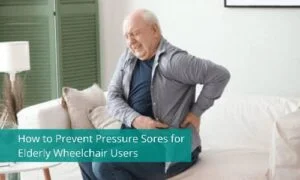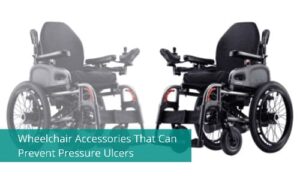“The presence of pressure ulcers is the third leading cause of death” for wheelchair users, which is why it is important to know what pressure sores are. It’s also essential to understand who is most prone to pressure sores, how to prevent pressure sores in elderly wheelchair users, and what accessories can help reduce the chance of pressure sores. First, we will start by explaining what exactly a pressure sore is and what causes them.
What is a pressure sore?
A pressure sore or pressure ulcer is skin damage caused to an area of the body because of staying in one position for too long. They are most commonly found in areas close to bones like the hips, back, elbows, and ankles. If not quickly treated, the damage to the skin can lead to serious infections that can later become life-threatening. Over time, the damage caused to the skin can lead to skin loss, tissue loss, infection, and in extreme cases, necrosis.
What do the different stages of pressure ulcers look like?
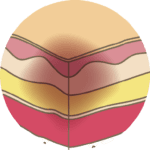 |
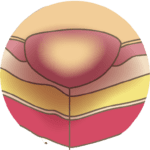 |
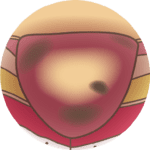 |
| Stage 1 | Stage 2 | Stage 3 |
| The skin looks inflamed and may be tender but otherwise, the injury is superficial at this stage. | The skin has started to break down and the area may be red and moist as a result of microclimate and shear. | Skin and tissue loss have occurred with exposed muscle or even bone. At this stage, the patient is prone to infections and permanent tissue damage. |
Where are the most common areas for pressure sores?
-
- Back of the heard
- Shoulder blades
- Spinous process
- Elbow
- Greater trochanter
- Sacrum
- Coccyx
- Ischial tuberosity
- Heels

Areas with skin close to bone are most susceptible to pressure sores. For a wheelchair user, there are where the user is in contact with the wheelchair surface, incorrectly. Source: Karma Medical
What are the causes of pressure sores?
The internal factors come from within the body and make patients more likely to sustain pressure injuries. These factors include but are not limited to:
-
- Limited mobility
- Age
- Chronic disease or postural deformities
- Medical conditions that affect blood flow
- Smoking
- Malnutrition and dehydration
- Urinary and fecal incontinence
External factors come from a patient’s environment such as sitting in a wheelchair incorrectly. The three main external factors are Pressure, Shear, and Microclimate (temperature and humidity).
Pressure
What is pressure? ‘Pressure’ is a continuous force against a surface or object. For wheelchair users, the seat and backrest are in constant contact with the user’s body.
It is the constant pressure against bony areas of the body that causes pressure injuries as a result of lack of proper pressure distribution or the right seat cushion and back support. The level of skin damage will depend on the layers of skin that are affected.
Stage 1: This is when the skin starts to look inflamed but is undamaged, only affecting the epidermal layer of the skin.
Stage 2: The pressure starts to break down the skin and cause an open wound as the pressure moves down to the dermis.
Stage 3: All three layers of the skin are penetrated by the pressure from the bone. The skin damage can potentially go as deep as the muscle to the bone.
Shear
Shear is a combination of downward pressure and friction. Shear or Shear force occurs in wheelchair users when they move, but how is it different from pressure?
Pressure is visually obvious because it is clear to see when the skin starts to become red and breaks down however shear is less obvious. Shear starts at the bone and bone tissue and works its way outwards to the skin surface which is why it can go undetected for longer compared to pressure injuries.
Shear most commonly happens to wheelchair users when;
-
- The wheelchair is the wrong size which causes the user to slide into the incorrect sitting posture.
- The user has a lack of trunk/pelvic support which results in a lot of unnecessary movement.
- The user transfers in and out of the wheelchair.
- The user is being continuously repositioned into a more “comfortable” sitting position.
Microclimate
Microclimate is not a direct cause of pressure sores but it does increase the effects of pressure and shear. Increased skin temperature and moisture will weaken the outer skin layers, making the layers of tissue, muscle, and bone more at risk of pressure and shear force.
The more common causes of microclimate include sweat, incontinence, wound fluid, sitting on a non-breathable fabric.
How does elevated body temperature elevate the effects of pressure and shear?
- The metabolic rate increases the need for oxygen to be delivered to skin tissue however pressure and shear cut off the oxygen supply to the skin. But as the skin needs more oxygen, there is less supply and ischemia occurs quicker.
How does extreme moisture elevate the effects of pressure and shear?
- Moisture increases the friction of the skin which means it is more likely to “stick” to a surface. As moisture weakens the outer skin layers (dermis and epidermis), it exposes the blood vessels to further skin damage from shear and pressure.
Understanding pressure sores will help prevent them
Understanding the main cause of pressure sores in wheelchair users is the easiest way to prevent them. Although some groups are more prone to getting pressure sores; pressure, shear, and microclimate can affect all wheelchair users. In the following blogs we will discuss who is prone to pressure sores, how to prevent pressure sores for the elderly, and wheelchair accessories that can help prevent pressure sores.
Keep Reading

 Global
Global
